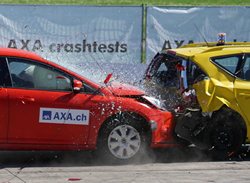Cynthia Sequin* says researchers have demonstrated how drones can be used to make safer and faster traffic crash site assessments with greater accuracy.
 A new method uses drones to make traffic crash site assessments safer, faster, and more accurate, according to new research.
A new method uses drones to make traffic crash site assessments safer, faster, and more accurate, according to new research.
Idling in a long line of slowed or stopped traffic on a busy highway is more than an inconvenience for drivers and highway safety officers.
It is one of the most vulnerable times for “secondary accidents,” which can often be worse than an original source of the slowdown, according to the US Department of Transportation’s Federal Highway Administration.
In fact, secondary crashes go up by a factor of almost 24 during the time that highway safety officials are assessing and documenting the crash site.
“It’s the people at the back of the queue where you have traffic stopped who are most vulnerable and an approaching inattentive driver doesn’t recognise that traffic is stopped or moving very slowly until it is too late,” says Darcy Bullock, Professor of Civil Engineering and Joint Transportation Research Program Director at Purdue University.
“The occurrence of these secondary crashes can be reduced by finding ways to safely expedite the clearance time of the original crash.”
Conventional mapping of a severe or fatal crash can take two to three hours depending on the severity of the accident, Bullock says.
“Our procedure for data collection using a drone can map a scene in five to eight minutes, allowing public safety officers to open the roads much quicker after an accident,” says Ayman Habib, a Professor of Civil Engineering who developed the photogrammetric procedures and envisions even more uses for the technology.
The technology is already in use.
The Sherriff’s Office in Tippecanoe County, Indiana, used drones to map crash scenes 20 times in 2018 and another 15 times in the same year to support specialty law enforcement teams throughout the County and in neighbouring Counties and jurisdictions.
“Overall, it can cut 60 per cent off the down time for traffic flow following a crash,” says Captain Robert Hainje of the Tippecanoe County Sheriff’s Office.
“The drone technology with the thermal imaging capability helps with all types of emergencies such as search and rescue, aerial support over water for diver teams or in wooded areas, and for fugitive apprehension,” Hainje says.
Safer scene analysis
John Bullock from the School of Mechanical Engineering and a research assistant on the project worked with local public safety colleagues to develop field procedures and post processing of images to create orthorectified images that clearly illustrate the position of vehicles, infrastructure, and general terrain adjacent to the crash site.
The researchers program the drones to use a grid-type path and record about 100 photos in two-second intervals.
Researchers use this post processed data to develop an accurate scale map that, with photos at the scene, provides enough data to create a 3D print of the scene.
“The technology is so much faster than traditional ground-based measurements and provides a much better comprehensive documentation that it opens up all different kinds of research,” Habib says.
“It can provide high-quality maps, imagery, and models for post-crash investigation by engineers and public safety officials.”
“This technology has many other civil engineering applications beyond crash scene mapping and can be used to estimate the volume of material needed or used for a construction project within a couple of percentage points.”
“It is very rewarding to see how this technology can be used to improve safety by reducing secondary crashes and exposure of colleagues to the hazards of working adjacent to highway traffic.”
Bullock, Habib, and colleagues from the Tippecanoe County Sheriff’s Office presented their findings at the annual Transportation Research Board meeting in Washington, DC.
* Cynthia A. Sequin is Assistant Vice President of Marketing and Communications at Purdue Research Foundation in Indiana.
This article first appeared at www.futurity.org.



